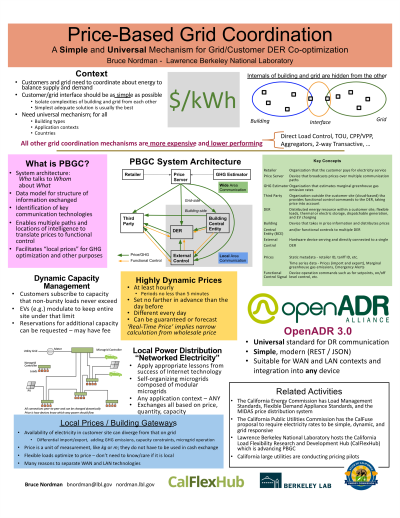Back

Finance and Asset Management
Price-Based Grid Coordination - A Simple and Universal Mechanism for Grid/Customer DER Co-optimization
Tuesday, September 12, 2023
4:30 PM - 5:30 PM PDT
Location: Poster Area, Booth #11024, Level 1, Venetian Expo Hall


Bruce Nordman, M.A., UC Berkeley
Scientist
Lawrence Berkeley National Laboratory
Berkeley, California, United States
Poster Presenter(s)
Aim/
Objective:
This presentation will cover the communication architecture for how California’s emerging Highly Dynamic Prices will be sent to customers and devices they own. This is essential for demand flexibility to work at all, and ideally can be the standard nationally and globally. The purpose is to convey the need for and details of the mechanism.
Methods:
The presentation will outline and delve into the details of the system, including data that needs to be communicated, communication paths, physical layer communication involved, and application layer protocols used, including OpenADR. Utility grid prices will be the primary driver of DER operation, but the concept of a local price allows for exactly the same mechanism for balancing supply and demand to be utilized when islanded from the grid. A report describing the system and details will also be freely available.
Results:
Attendees will understand the technology that they need to incorporate into their products and systems to deliver the greatest value to customers in California and beyond. They will also gain some appreciation for how pricing can outperform other approaches, at lower cost.
Conclusion:
Price-based Grid Coordination is intended to be the fundamental mechanism for activating the value of DER for the utility grid and for customers, analogous to the role that the Internet Protocol plays in our communication technology. It is highly practical for inclusion in products such as flexible loads, batteries, and EV charging. Every month more utilities announce ever more dynamic rates, highlighting the need for a common solution. Pricing can also drive microgrid operation - for single-customer and multi-customer microgrids.
Objective:
This presentation will cover the communication architecture for how California’s emerging Highly Dynamic Prices will be sent to customers and devices they own. This is essential for demand flexibility to work at all, and ideally can be the standard nationally and globally. The purpose is to convey the need for and details of the mechanism.
Methods:
The presentation will outline and delve into the details of the system, including data that needs to be communicated, communication paths, physical layer communication involved, and application layer protocols used, including OpenADR. Utility grid prices will be the primary driver of DER operation, but the concept of a local price allows for exactly the same mechanism for balancing supply and demand to be utilized when islanded from the grid. A report describing the system and details will also be freely available.
Results:
Attendees will understand the technology that they need to incorporate into their products and systems to deliver the greatest value to customers in California and beyond. They will also gain some appreciation for how pricing can outperform other approaches, at lower cost.
Conclusion:
Price-based Grid Coordination is intended to be the fundamental mechanism for activating the value of DER for the utility grid and for customers, analogous to the role that the Internet Protocol plays in our communication technology. It is highly practical for inclusion in products such as flexible loads, batteries, and EV charging. Every month more utilities announce ever more dynamic rates, highlighting the need for a common solution. Pricing can also drive microgrid operation - for single-customer and multi-customer microgrids.
